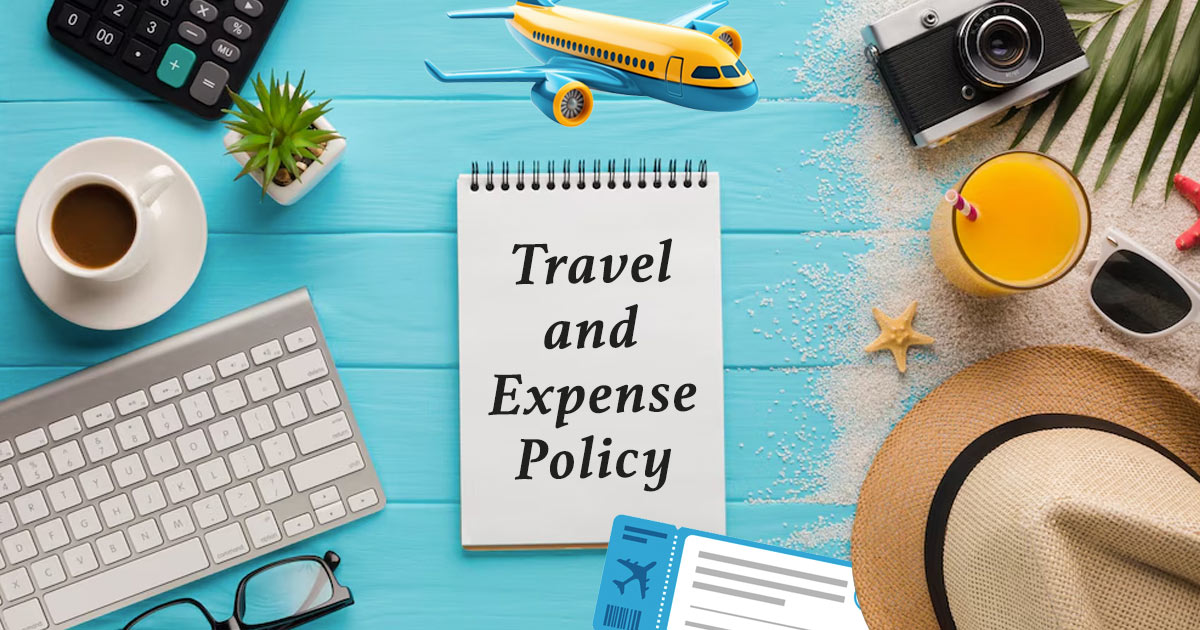Travel and Expense Policy Best Practices to Save Time & Money

Managing travel expenses can be difficult for businesses, especially as travel budgets grow. Global business travel is expected to grow nearly $1.8 trillion by 2027, making it essential to find ways to control costs. A clear and effective travel and expense (T&E) policy helps businesses avoid overspending, speed up approvals, and keep employees happy.
If you’re wondering how to improve your travel and expense process or create a T&E policy, this guide will break down the basics and share tips to simplify expense management.
What Is a T&E Policy?
A T&E or travel and expense policy, sets the rules for how employees can spend company money during work travel or client entertainment. These expenses can include airfare, hotel stays, local transportation, meals, and more.
For example, buying a business-class ticket for a short flight or charging a personal gym membership to the company wouldn’t be covered. A T&E policy keeps things fair and ensures employees know what’s allowed and what isn’t.
Without a policy, businesses can lose control of their travel costs. Overspending, unclear guidelines, and delays in reimbursements could create chaos. Follow these best practices to keep things running smoothly.
Must-set Practices for Travel and Expense Policies
1. Define Allowable Expenses
Break down exactly what expenses are covered during business trips. For instance, airfare should typically be booked in economy class unless it’s a long-haul flight. Similarly, clarify how much employees can spend daily on meals or transport.
Also, be clear about non-reimbursable items, like personal entertainment or unnecessary upgrades. Using a sample T&E policy as a template can save time and ensure nothing gets missed.
2. Set Daily Allowances with Per Diems
A per diem is a daily allowance that simplifies travel budgets. For example, employees traveling to New York City could receive a set amount, like $75 per day, to cover meals and other small expenses.
This approach reduces the need for collecting endless receipts while helping team members stick to a budget. Use tools like the U.S. General Services Administration (GSA) website to find appropriate per diem rates for different locations.
3. Require Pre-Approval for Big Expenses
To stay on top of your T&E budget, set up a pre-approval step for significant costs like airfares, hotels, or conferences. Employees should share details of the trip, costs, and reasons for approval before making bookings.
For example, some companies use tools like Concur to automate this process, helping managers approve or suggest changes quickly while sticking to policy limits.
4. Use Technology for Expense Tracking
Gone are the days of clunky spreadsheets. Tools like Expensify or TravelPerk allow employees to upload receipts, track spending, and ensure compliance automatically. These platforms often have alerts to flag overspending or non-compliant bookings in real time.
For instance, a tech company, Adsquare, used TravelPerk to quicken approvals. Employees could filter their choices to show only options aligning with company policies, cutting down on back-and-forth emails.
5. Simplify Reimbursements
Quick reimbursements can make all the difference for employees needing to recover out-of-pocket costs. Use mobile apps where employees can upload receipts directly and link these to your expense system.
Set clear deadlines, like processing claims within five business days. Clear rules and efficient systems lead to happier, less stressed teams.
6. Centralize Everything in One System
Instead of using multiple tools and email threads, use a single platform to combine travel booking, expense tracking, and approval workflows. For instance, platforms like SAP Concur or Zoho Expense allow employees to book hotels and flights, submit expenses, and see all policies in one place.
This simplifies things for employees and gives finance teams an overview of spending trends.
7. Educate and Communicate with Employees
Policies only work if employees understand and follow them. Keep your travel and expense policy simple and easy to access via an internal portal or app. Use short training sessions or videos to explain the basics.
Also, ask employees for feedback. For example, if travelers repeatedly overspend on hotels in specific cities, it might mean that your expense limits need adjusting.
8. Regularly Update Your Policy
Business needs and travel costs change over time. That’s why it’s essential to audit and update your policy regularly. For instance, if several employees find it hard to find meals under your per diem rate in major cities, adjust the limit accordingly.
Frequent checks also help you stay compliant with tax laws and other regulations. Updating your policy shows employees that the company listens and adapts to their real-life challenges.
Building Trust and Efficiency Through Smarter T&E Policies
A good travel and expense policy isn’t just about cutting costs or following rules. It’s about making things easier and building trust within your team. Picture an employee booking a trip without stress, knowing they’ll be reimbursed quickly. Or imagine a manager using simple tools to track spending instead of juggling spreadsheets. That’s the kind of balance a well-designed policy can bring.
The best policies don’t just set rules; they help employees make smart spending choices. It’s about giving them the tools they need, being clear about expectations, and listening to their feedback.
